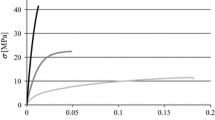Abstract
An analytical model is developed to correlate the mode I fracture energy of toughened epoxy adhesive joints with microdamage mechanisms generated around a crack tip. The analytical expression for the mode I fracture energy is derived on the basis of total energy dissipation during crack extension. Three dominant damage modes, plastic shear band formation, plastic void growth, and plastic deformation of the entire matrix resin in a crack-tip region, are identified in the proposed model as the primary energy dissipation mechanisms. Numerical results show that the models can predict the effects of adhesive thickness on the mode I fracture energy of toughened adhesive joints. The analytical model involving material constants and microstructural variables should provide some guidelines toward achieving optimum fracture toughness for these types of adhesive joints.
Similar content being viewed by others
References
Bascom, W.D., Cottington, R.L., Jones, R.L. and Peyser, P. (1975). The fracture of epoxy-and elastomer-modified epoxy polymers in bulk and as adhesives. Journal Applied Polymer Science 19, 2545–2562.
Bascom, W.D. and Cottington, R.L. (1976). Effect of temperature on the adhesive fracture behavior of an elastomerepoxy resin. Journal of Adhesion 7, 333–346.
Chai, H. (1986). Bond thickness effect in adhesive joints and its significance for mode I interlaminar fracture of composites, in Composite Materials: Testing and Design (Seventh Conference), ASTM STP893, J.M. Whitney (ed.) American Society for Testing and Materials, Philadelphia 209–231.
Chakachery, E.A. (1989). Delamination micromechanisms in polymeric matrices and carabon fibre reinforced composites, PhD dissertation, Texas A&M University.
Daghyani, H.R. Ye, L. and Mai, Y.W. (1995). Mode I fracture behaviour of adhesive joints. Part I. Relationship between fracture energy and bond thickness. Journal of Adhesion 53, 149–162.
Evans, A.G., Ahmad Z.B., Gilbert, D.G. and Beaumont, P.W.R. (1986). Mechanisms of toughening in rubber toughened polymers. Acta Metallurgica 34, 79–87.
Garg, A.C. and Mai, Y.W. (1988). Failure mechanisms in toughened epoxy resins — A review. Composite Science and Technology 31, 179–223.
Huang, Y. and Kinloch, A.J. (1992a), Modelling of the toughening mechanisms in rubber-modified epoxy polymers. Part I. Finite element analysis studies. Journal of Materials Science Letters 27, 2753–2762.
Huang, Y. and Kinloch, A.J. (1992b), Modelling of the toughening mechanisms in rubber-modified epoxy polymers. Part II. A quantitative description of the microstructure-fracture property relationship. Journal of Materials Science Letters, 2763–2769.
Huang, Y. and Kinloch, A.J. (1992c). The role of plastic void growth in the fracture of rubber-toughened epoxy polymers. Journal of Materials Science Letters 11, 484–487.
Hunston, D.J., Kinloch, A.J. and Wang, S.S. (1989). Micromechanics of fracture in structural adhesive bonds. Journal of Adhesion 28, 103–114.
Kinloch, A.J. (1989). Relationships between the microstructure and fracture behavior of rubber-toughened thermosetting polymers, in Rubber-Toughened Plastics (Edited by C.K. Riew), Advances in Chemistry Series 222, American Chemical Society, Washington DC, 67–91.
Kinloch, A.J. and Shaw, S.J. (1981). The fracture resistance of a toughened epoxy adhesive. Journal of Adhesion 12, 59–77.
Pearson, P.A. and Yee, A.F. (1986). Toughening mechanisms in elastomer-modified epoxies. Part 2. Microscopy studies. Journals of Materials Science 21, 2475–2488.
Tohdoh, M., Chaturvedi, S.K. and Sierakowski, R.L. (1996). Mode I fracture modeling of elastomer-toughened polymers. International Journal of Fracture 75, 283–306.
Wang, S.S., Mandell, J.F. and McGarry, F.J. (1978). An Analysis of the crack-tip stress field in DCB adhesive fracture specimens. International Journal of Fracture 14, 39–58.
Author information
Authors and Affiliations
Rights and permissions
About this article
Cite this article
Todo, M., Chaturvedi, S. & Sierakowski, R. Mode I fracture modeling of elastomer toughened epoxy adhesive joints. International Journal of Fracture 85, 301–312 (1997). https://doi.org/10.1023/A:1007485711458
Issue Date:
DOI: https://doi.org/10.1023/A:1007485711458




